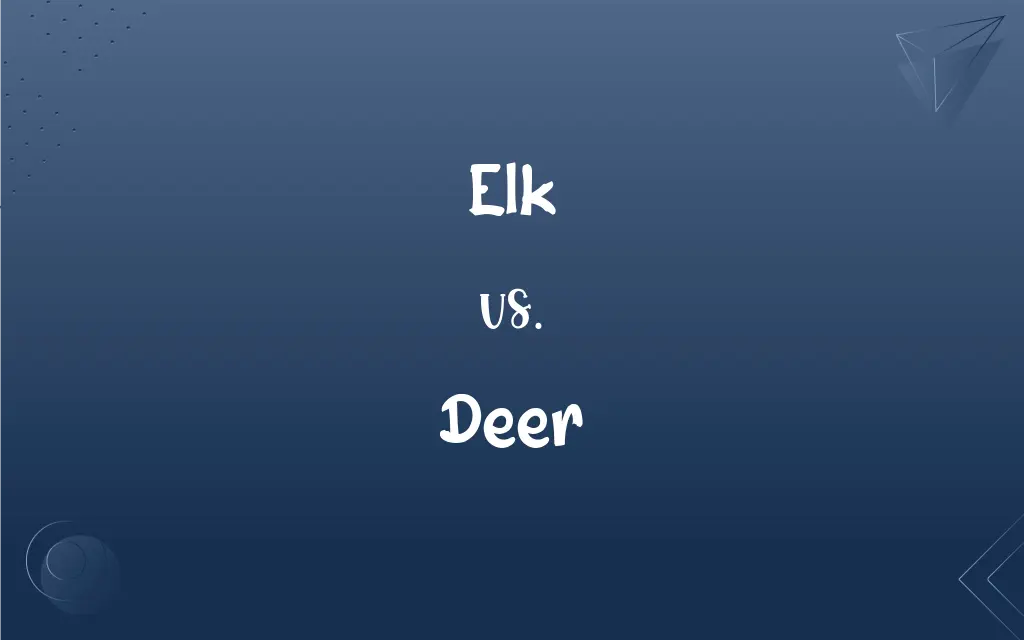Elk vs. Deer: What's the Difference?
Edited by Janet White || By Harlon Moss || Updated on October 10, 2023
Elk are larger, have thicker bodies and more even color, while deer are smaller and typically have a mix of reddish-brown and white fur. Both are members of the Cervidae family, but different species.

Key Differences
Elk and deer, both members of the Cervidae family, exhibit distinctive physical characteristics. While elk are notably larger, often weighing 500-1300 pounds, deer are considerably smaller, with their weight ranging commonly between 90-300 pounds. This size discrepancy becomes a notable identifier when comparing the two.
Examining antlers provides another clear distinction between elk and deer. Elk antlers, notably in males, are larger and can grow up to 4 feet with a unique, branching structure. In contrast, deer antlers tend to be smaller and, depending on the species, exhibit varied branching patterns, offering a stark contrast in physical appearance.
Interestingly, the vocalizations of elk and deer further highlight their differences. Elk are renowned for their audible bugling, a high-pitched sound that resonates during mating seasons. Conversely, deer sounds are generally not as loud or as distinctive as the elk's bugling, typically consisting of grunts, bleats, and occasionally, loud distress calls.
Both creatures exhibit behavioral contrasts too. Elk are typically more herd-oriented, often found in groups, whether it’s the females (cows) or males (bulls). On the other hand, deer, while they can be observed in groups, tend to display more solitary behaviors, particularly among males, which are often seen alone.
Habitat and range also present key differentiators. Elk are primarily found in western North America and are adapted to various habitats, including forests, grasslands, and savannas. Deer, meanwhile, boast a wider range, being distributed across multiple continents and thriving in various environments from forests to grasslands and even in suburban areas, demonstrating their adaptable nature.
ADVERTISEMENT
Comparison Chart
Size
Larger, up to 1300 pounds
Smaller, usually 90-300 pounds
Antler Characteristics
Larger, up to 4 feet
Smaller and varied
Vocalizations
Distinctive, high-pitched bugling
Generally soft, varied calls
Behavior
More herd-oriented
Can be solitary or in groups
Habitat and Range
Primarily western North America
Widespread globally
ADVERTISEMENT
Elk and Deer Definitions
Elk
Elk are herbivorous, consuming a variety of plants and grasses.
In the meadow, the elk grazed calmly on the lush grasses.
Deer
Deer, especially fawns, are often symbolized as creatures of innocence and gentleness.
The fawn, a young deer, explored its surroundings with curiosity.
Elk
Elk often reside in forests and grasslands, adapting to varied habitats.
The elk herd moved through the expansive, tree-covered forest.
Deer
Being herbivorous, deer primarily consume leaves, grass, and occasionally fruits.
The deer delicately nibbled on the apple left by a picnicker.
Elk
Notable for their vocalizations, elk emit a distinct bugling sound, especially during mating seasons.
At night, the eerie sound of the elk's bugling echoed through the valley.
Deer
A deer is a medium-sized mammal known for its nimbleness and speed.
The deer leapt gracefully over the log.
Elk
An elk is a large mammal recognized for its impressive antlers.
The elk lifted its head, displaying its massive antlers.
Deer
Deer are widely distributed and can inhabit various ecosystems, including forests and grasslands.
We glimpsed a deer peering at us from the dense forest edge.
Elk
Elk are known for their sociable nature, often forming large herds.
The observer was fascinated by the structured dynamics within the elk herd.
Deer
Deer exhibit sexual dimorphism, with usually only males sporting antlers.
The male deer, or buck, showcased its antlers during mating season.
Elk
A large reddish-brown or grayish deer (Cervus canadensis) of western North America, having long, branching antlers in the male. The elk is sometimes considered a subspecies of the closely related red deer. Also called wapiti.
Deer
Any of various hoofed ruminant mammals of the family Cervidae, characteristically having deciduous antlers borne chiefly by the males. The deer family includes the white-tailed deer, elk, moose, and caribou.
Elk
Chiefly British The moose.
Deer
A ruminant mammal with antlers and hooves of the family Cervidae, or one of several similar animals from related families of the order Artiodactyla.
Deer
(in particular) One of the smaller animals of this family, distinguished from a moose or elk
I wrecked my car after a deer ran across the road.
Deer
The meat of such an animal; venison.
Oh, I've never had deer before.
FAQs
What family do elk and deer belong to?
Both belong to the Cervidae family.
Are elk bigger than deer?
Yes, elk are generally larger and heavier than deer.
Do both male and female deer have antlers?
Typically, only male deer have antlers.
What is a female deer called?
A female deer is referred to as a doe.
Is the elk native to North America?
Yes, elk are primarily found in western North America.
Are deer active during the day or night?
Deer are crepuscular, being most active during dawn and dusk.
Are deer considered a game animal?
Yes, deer are commonly hunted as game in many areas.
What is the lifespan of an elk in the wild?
Elk typically live 10-13 years in the wild.
Are elk populations stable?
Elk populations are considered stable in many regions, but threats exist.
Can deer adapt to suburban environments?
Yes, deer are known to adapt and can often be found near human habitats.
Do both elk and deer engage in mating battles using their antlers?
Yes, males of both species use their antlers to battle for mating privileges.
Can deer be found globally?
Yes, deer species are distributed across various continents.
Do both elk and deer exhibit herding behaviors?
Elk are more typically herd-oriented, while deer can be solitary or form groups.
What is a group of elk called?
A group of elk is commonly referred to as a herd.
Is “hart” another term for deer?
Yes, “hart” is an old term, often used for a mature male deer.
What is the main diet of an elk?
Elk are herbivorous, primarily eating grasses, plants, and shrubs.
What sound is characteristic of elk?
Elk are known for their distinctive bugling calls.
How many species of deer are there?
There are over 60 species of deer worldwide.
Do elk and deer have predators?
Yes, both face predators like wolves, bears, and humans.
Do deer and elk shed their antlers?
Yes, both deer and elk shed and regrow their antlers annually.
About Author
Written by
Harlon MossHarlon is a seasoned quality moderator and accomplished content writer for Difference Wiki. An alumnus of the prestigious University of California, he earned his degree in Computer Science. Leveraging his academic background, Harlon brings a meticulous and informed perspective to his work, ensuring content accuracy and excellence.
Edited by
Janet WhiteJanet White has been an esteemed writer and blogger for Difference Wiki. Holding a Master's degree in Science and Medical Journalism from the prestigious Boston University, she has consistently demonstrated her expertise and passion for her field. When she's not immersed in her work, Janet relishes her time exercising, delving into a good book, and cherishing moments with friends and family.































































